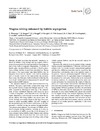Please use this identifier to cite or link to this item:
https://accedacris.ulpgc.es/jspui/handle/10553/72168
| Title: | Magma mixing enhanced by bubble segregation | Authors: | Wiesmaier, S. Morgavi, D. Renggli, C. J. Perugini, D. De Campos, C. P. Hess, K-U. Ertel-Ingrisch, W. Lavallee, Y. Dingwell, D. B. |
UNESCO Clasification: | 250621 Vulcanología | Keywords: | Chaotic Advection Element Mobility Diffusion Viscosity Dynamics, et al |
Issue Date: | 2015 | Journal: | Solid Earth | Abstract: | In order to explore the materials' complexity induced by bubbles rising through mixing magmas, bubble-advection experiments have been performed, employing natural silicate melts at magmatic temperatures. A cylinder of basaltic glass was placed below a cylinder of rhyolitic glass. Upon melting, bubbles formed from interstitial air. During the course of the experimental runs, those bubbles rose via buoyancy forces into the rhyolitic melt, thereby entraining tails of basaltic liquid. In the experimental run products, these plume-like filaments of advected basalt within rhyolite were clearly visible and were characterised by microCT and high-resolution EMP analyses.The entrained filaments of mafic material have been hybridised. Their post-experimental compositions range from the originally basaltic composition through andesitic to rhyolitic composition. Rheological modelling of the compositions of these hybridised filaments yield viscosities up to 2 orders of magnitude lower than that of the host rhyolitic liquid. Importantly, such lowered viscosities inside the filaments implies that rising bubbles can ascend more efficiently through pre-existing filaments that have been generated by earlier ascending bubbles. MicroCT imaging of the run products provides textural confirmation of the phenomenon of bubbles trailing one another through filaments. This phenomenon enhances the relevance of bubble advection in magma mixing scenarios, implying as it does so, an acceleration of bubble ascent due to the decreased viscous resistance facing bubbles inside filaments and yielding enhanced mass flux of mafic melt into felsic melt via entrainment. In magma mixing events involving melts of high volatile content, bubbles may be an essential catalyst for magma mixing.Moreover, the reduced viscosity contrast within filaments implies repeated replenishment of filaments with fresh end-member melt. As a result, complex compositional gradients and therefore diffusion systematics can be expected at the filament-host melt interface, due to the repetitive nature of the process. However, previously magmatic filaments were tacitly assumed to be of single-pulse origin. Consequently, the potential for multi-pulse filaments has to be considered in outcrop analyses. As compositional profiles alone may remain ambiguous for constraining the origin of filaments, and as 3-D visual evidence demonstrates that filaments may have experienced multiple bubbles passages even when featuring standard diffusion gradients, therefore, the calculation of diffusive timescales may be inadequate for constraining timescales in cases where bubbles have played an essential role in magma mixing. Data analysis employing concentration variance relaxation in natural samples can distinguish conventional single-pulse filaments from advection via multiple bubble ascent advection in natural samples, raising the prospect of yet another powerful application of this novel petrological tool. | URI: | https://accedacris.ulpgc.es/handle/10553/72168 | ISSN: | 1869-9510 | DOI: | 10.5194/se-6-1007-2015 | Source: | Solid Earth [ISSN 1869-9510], v. 6 (3), p. 1007-1023, (2015) |
| Appears in Collections: | Artículos |
SCOPUSTM
Citations
23
checked on Jun 8, 2025
WEB OF SCIENCETM
Citations
20
checked on Jun 8, 2025
Page view(s)
69
checked on Feb 10, 2024
Download(s)
91
checked on Feb 10, 2024
Google ScholarTM
Check
Altmetric
Share
Export metadata
Items in accedaCRIS are protected by copyright, with all rights reserved, unless otherwise indicated.
